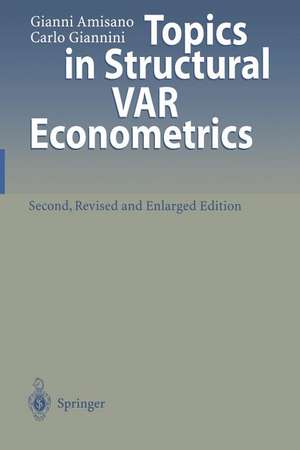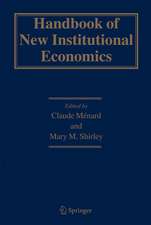Topics in Structural VAR Econometrics
Autor Gianni Amisano, Carlo Gianninien Limba Engleză Paperback – 18 sep 2011
Preț: 635.65 lei
Preț vechi: 747.82 lei
-15% Nou
Puncte Express: 953
Preț estimativ în valută:
121.66€ • 125.38$ • 102.71£
121.66€ • 125.38$ • 102.71£
Carte tipărită la comandă
Livrare economică 03-17 martie
Preluare comenzi: 021 569.72.76
Specificații
ISBN-13: 9783642644818
ISBN-10: 3642644813
Pagini: 200
Ilustrații: XIII, 181 p.
Dimensiuni: 155 x 235 x 11 mm
Greutate: 0.29 kg
Ediția:2nd ed. 1997. Softcover reprint of the original 2nd ed. 1997
Editura: Springer Berlin, Heidelberg
Colecția Springer
Locul publicării:Berlin, Heidelberg, Germany
ISBN-10: 3642644813
Pagini: 200
Ilustrații: XIII, 181 p.
Dimensiuni: 155 x 235 x 11 mm
Greutate: 0.29 kg
Ediția:2nd ed. 1997. Softcover reprint of the original 2nd ed. 1997
Editura: Springer Berlin, Heidelberg
Colecția Springer
Locul publicării:Berlin, Heidelberg, Germany
Public țintă
ResearchCuprins
l: From VAR models to Structural VAR models.- 1.1. Origins of VAR modelling.- 1.2. Basic concepts of VAR analysis.- 1.3. Efficient estimation: the BVAR approach.- 1.4. Uses of VAR models.- 1.5. Different classes of Structural VAR models.- 1.6. The likelihood function for SVAR models.- 1.7. Structural VAR models vs. dynamic simultaneous equations models.- 1.8. Some examples of Structural VARs in the applied literature.- 2: Identification analysis and F.I.M.L. estimation for the K-Model.- 2.1. Identification analysis.- 2.2. F.I.M.L. estimation.- 3: Identification analysis and F.I.M.L. estimation for the C-Model.- 3.1. Identification analysis.- 3.2. F.I.M.L. estimation.- 4: Identification analysis and F.I.M.L. estimation for the AB-Model.- 4.1. Identification analysis.- 4.2. F.I.M.L. estimation.- 5: Impulse response analysis and forecast error variance decomposition in SVAR modeling.- 5.1. Impulse response analysis.- 5.2. Variance decomposition (by Antonio Lanzarotti).- 5.3. Finite sample and asymptotic distributions for dynamic simulations.- 6: Long run a priori information. Deterministic components. Cointegration.- 6.1. Long run a priori information.- 6.2. Deterministic components.- 6.3. Cointegration.- 7: Model selection in Structural VAR analysis.- 7.1. General aspects of the model selection problem.- 7.2. The dominance ordering criterion.- 7.3. The likelihood dominance criterion (LDC).- 8: The problem of non fundamental representations.- 8.1. Non fundamental representations in time series models.- 8.2. Economic significance of non fundamental representations and examples.- 8.3. Non fundamental representations and applied SVAR analysis.- 8.4. An example.- 9: Two applications of Structural VAR analysis.- 9.1. A traditional interpretation of Italian macroeconomic fluctuations.- 9.2. The transmission mechanism among Italian interest rates.- Annex 1: The notions of reduced form and structure in Structural VAR modelling.- Annex 2: Some considerations on the semantics, choice and management of the K, C, and AB-models.- Appendix A.- Appendix B.- Appendix C (by Antonio Lanzarotti and Mario Seghelini).- References.










